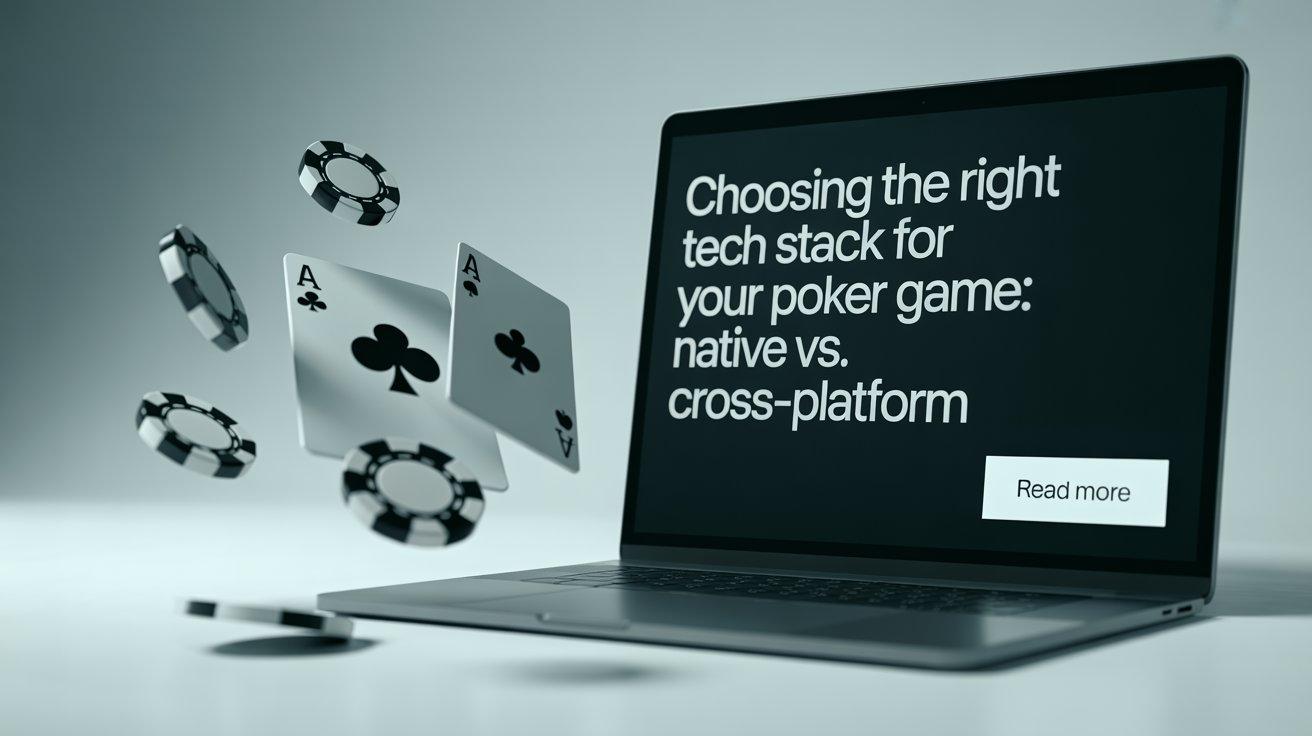Спонсоры
Choosing the Right Tech Stack for Your Poker Game: Native vs. Cross-Platform

Digital platforms have transformed the way poker is played, making it accessible to millions of users worldwide. Whether you’re planning to build a mobile poker app or a web-based platform, one of the most crucial decisions you’ll face is choosing the right tech stack. And at the center of that decision is the question: should you go native or cross-platform?
If you’ve ever spoken to a poker game development company or researched game design yourself, you’ve probably seen this debate play out. Both approaches offer unique strengths, and both come with trade-offs. To make the right choice, you need to understand the core differences, the impact on user experience, and what works best for your vision.
Understanding Native Development
When we say "native development," we mean building an app specifically for one operating system, such as iOS (using Swift or Objective-C) or Android (using Java or Kotlin). A native app is built with tools that the platform itself provides, which means it’s optimized to run smoothly on that operating system.
Advantages of Native Development:
-
Performance at Its Best
Native apps are known for being fast and responsive. Since they’re built specifically for the platform, they can access hardware features like the camera, GPS, or push notifications without any middle layers slowing things down. For a poker game where animations, card movements, and real-time interactions are key, this performance advantage can be noticeable. -
Better User Experience
Players expect a poker app to feel intuitive. On iOS, users are used to a certain style of navigation; on Android, it’s slightly different. Native apps align with these expectations, which makes them feel more natural and user-friendly. -
Access to Latest Features
Whenever Apple or Google release updates, native apps can immediately tap into those features. For a game that evolves over time, this means you can roll out enhancements faster.
Drawbacks of Native Development:
-
Higher Cost: Building separate apps for iOS and Android means doubling up on development.
-
More Maintenance: Every update has to be done twice, once for each version.
-
Longer Development Time: You’ll need separate teams, which can slow down your time to market.
Understanding Cross-Platform Development
Cross-platform development allows you to build one app that runs on multiple platforms. Popular frameworks like Flutter, React Native, and Unity make this possible. Instead of writing code twice, you write it once and deploy it everywhere.
Advantages of Cross-Platform Development:
-
Cost-Effective
A single codebase means you don’t need two separate development teams. This reduces costs significantly, which is especially appealing for startups or businesses testing the waters in online poker. -
Faster to Market
Since you’re building one app instead of two, development time is shorter. You can launch quickly and start gathering feedback from players sooner. -
Consistent Design
The game will look and function nearly the same across devices. Players switching from Android to iOS will enjoy a familiar experience.
Drawbacks of Cross-Platform Development:
-
Performance Trade-offs: While frameworks like Unity or Flutter are powerful, they sometimes can’t match the raw speed of native apps. For casual games this isn’t always noticeable, but in competitive poker, milliseconds can matter.
-
Limited Access to Advanced Features: Some device-specific capabilities may require additional workarounds.
-
Potential Bugs Across Platforms: Because the app has to run on multiple systems, minor bugs might appear differently on each.
Native vs. Cross-Platform: The Poker Game Angle
The choice between native and cross-platform isn’t just about technology, it's about the type of poker game you want to build and the audience you want to reach.
If You’re Building a High-Stakes Poker App:
For a high-performance poker tournament app with live multiplayer modes, complex animations, and features like voice chat or live streaming, native development might be the better option. Players in competitive games demand flawless experiences. Any lag or glitch could mean frustration, and native apps reduce those risks.
If You’re Building for a Wider Audience Quickly:
If your priority is reaching as many players as possible in the shortest time, cross-platform development has the edge. You can launch across iOS and Android simultaneously, build a user base, and refine your app as you go.
Costs and Team Considerations
Budget often plays a deciding role. Native development requires hiring specialized teams for each platform, which can quickly add up. Cross-platform, on the other hand, lets you hire a single team that can manage everything.
If you already have experienced poker game developers in-house with knowledge of a framework like Unity, you may find cross-platform development a more efficient path. Unity, in particular, is widely used for interactive and multiplayer games.
Long-Term Strategy
Your decision should also consider the future. Do you see your poker app as a long-term product with evolving features, or are you testing the market with a minimum viable product (MVP)?
-
For a long-term platform where you’ll need constant updates, new features, and deep integrations, native development ensures maximum flexibility.
-
For an MVP or testing phase, cross-platform development helps you get started quickly and adjust based on user feedback.
Beyond the Tech Stack: Other Factors That Matter
While the native vs. cross-platform debate is important, it’s not the only factor. Consider these aspects as well:
-
Security
In poker, security isn’t optional. Whether it’s safeguarding player data or ensuring fair gameplay, your tech stack must allow for advanced encryption and fraud detection systems. -
Scalability
Can your system handle thousands of players joining a tournament at once? Your infrastructure needs to grow as your user base expands. -
Monetization Options
Do you plan to use in-app purchases, ads, or subscription models? Your tech stack should make these features easy to implement. -
User Support
Smooth integration of chat, notifications, and support systems can enhance player loyalty.
Case for Professional Expertise
Choosing between native and cross-platform isn’t just a technical decision; it’s a business one. This is why working with the best poker game development company can make a huge difference. Experienced teams know how to balance performance, cost, and user experience to match your goals.
Some businesses also look beyond regular apps and aim for large-scale tournament platforms. In such cases, partnering with a poker tournament platform provider ensures you have the right systems to manage multiple games, leaderboards, and real-time payouts.
If you plan to go even further, investing in poker tournament software development can give you a competitive advantage. Custom-built systems designed specifically for managing tournaments can transform your offering from just another poker app to a full-fledged poker destination.
Final Thoughts
So, which is better native or cross-platform? The truth is, there’s no one-size-fits-all answer. It depends on your vision, budget, and long-term strategy.
-
If performance, advanced features, and user experience are your top priorities, native development is the way to go.
-
If speed, affordability, and market reach matter more right now, cross-platform can give you the head start you need.
Ultimately, it’s about aligning technology with business goals. Poker is more than just a game, it's an experience. And whether you build native or cross-platform, your focus should always be on giving players a smooth, secure, and engaging journey every time they log in.





